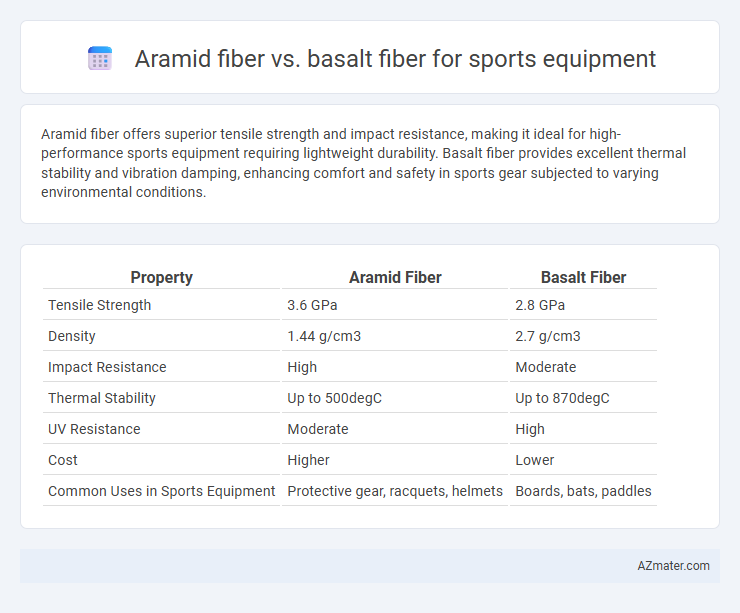Aramid fiber offers superior tensile strength and impact resistance, making it ideal for high-performance sports equipment requiring lightweight durability. Basalt fiber provides excellent thermal stability and vibration damping, enhancing comfort and safety in sports gear subjected to varying environmental conditions.
Table of Comparison
| Property | Aramid Fiber | Basalt Fiber |
|---|---|---|
| Tensile Strength | 3.6 GPa | 2.8 GPa |
| Density | 1.44 g/cm3 | 2.7 g/cm3 |
| Impact Resistance | High | Moderate |
| Thermal Stability | Up to 500degC | Up to 870degC |
| UV Resistance | Moderate | High |
| Cost | Higher | Lower |
| Common Uses in Sports Equipment | Protective gear, racquets, helmets | Boards, bats, paddles |
Introduction to Aramid and Basalt Fibers in Sports Equipment
Aramid fibers, known for their exceptional tensile strength and lightweight properties, are widely used in sports equipment such as helmets, protective gear, and high-performance racquets to enhance durability and impact resistance. Basalt fibers, derived from volcanic rock, offer superior thermal stability and vibration damping, making them ideal for sports applications like skis, snowboards, and bike frames where comfort and resilience under stress are crucial. The choice between aramid and basalt fibers depends on specific performance needs, balancing strength, weight, and environmental resistance in advanced sports technologies.
Material Composition and Properties
Aramid fiber, composed of synthetic aromatic polyamides, offers exceptional tensile strength, impact resistance, and lightweight properties, making it ideal for high-performance sports equipment such as helmets and racquets. Basalt fiber, derived from natural volcanic rock, provides excellent thermal stability, corrosion resistance, and higher stiffness, often enhancing durability in outdoor sports gear like protective pads and bike frames. Both fibers contribute unique mechanical and environmental advantages, with aramid emphasizing flexibility and shock absorption while basalt emphasizes rigidity and weather resistance.
Strength and Durability Comparison
Aramid fiber exhibits exceptional tensile strength and impact resistance, making it ideal for high-performance sports equipment such as helmets and protective pads. Basalt fiber offers superior durability and thermal stability, with excellent resistance to weathering and chemical corrosion, enhancing equipment longevity in outdoor conditions. While aramid fiber excels in energy absorption and lightweight strength, basalt fiber provides a cost-effective alternative with robust mechanical properties for long-term use.
Weight and Flexibility Differences
Aramid fiber is known for its exceptional strength-to-weight ratio, making it significantly lighter than basalt fiber, which contributes to enhanced agility in sports equipment. Basalt fiber offers superior flexibility compared to aramid fiber, allowing sports gear to absorb impacts more effectively and maintain durability under stress. Choosing between the two depends on the specific sport's requirements for lightweight performance versus flexibility and impact resistance.
Impact Resistance and Safety Performance
Aramid fiber demonstrates superior impact resistance compared to basalt fiber, making it a preferred choice for high-performance sports equipment designed to absorb and dissipate energy during collisions. Basalt fiber offers enhanced thermal stability and safety performance by resisting degradation under extreme conditions, though its impact resistance is generally lower than that of aramid fiber. Combining aramid fiber's exceptional toughness with basalt fiber's safety attributes can optimize protective sports gear for both impact protection and durability.
Cost Effectiveness and Availability
Aramid fiber offers high tensile strength and durability for sports equipment but comes with a higher cost, limiting its cost-effectiveness for budget-sensitive applications. Basalt fiber provides a more affordable alternative with decent mechanical properties and better availability due to its natural volcanic rock origin. Sports manufacturers often choose basalt fiber when balancing performance and cost efficiency, especially for mid-range products.
Moisture and Temperature Resistance
Aramid fiber exhibits excellent moisture resistance and maintains structural integrity in humid environments, making it ideal for sports equipment exposed to sweat and rain. Basalt fiber offers superior temperature resistance, withstanding extreme heat up to 650degC, which is beneficial for equipment used in high-temperature conditions or intense physical activities. Both fibers provide unique advantages, with aramid excelling in moisture-prone settings and basalt delivering durability under thermal stress.
Application Examples in Sports Gear
Aramid fiber is widely used in sports equipment such as high-performance helmets, protective gloves, and bicycle frames due to its exceptional tensile strength and impact resistance. Basalt fiber finds applications in tennis rackets, fishing rods, and golf clubs, offering a lightweight, vibration-dampening alternative with superior thermal stability. Both fibers enhance durability and performance, with aramid favored for extreme impact protection and basalt for comfort and weight reduction in sports gear.
Environmental Impact and Sustainability
Aramid fiber, known for its high strength-to-weight ratio and durability, is less environmentally friendly due to its petroleum-based origins and energy-intensive production process. Basalt fiber, derived from natural volcanic rock, offers a more sustainable alternative with lower carbon emissions and better recyclability, making it increasingly popular for eco-conscious sports equipment manufacturing. The use of basalt fiber reduces reliance on fossil fuels and supports circular economy principles, enhancing overall environmental sustainability in the sports industry.
Which Fiber is Better for Sports Equipment?
Aramid fiber offers exceptional strength-to-weight ratio and impact resistance, making it ideal for high-performance sports equipment like helmets and protective gear. Basalt fiber provides superior vibration damping and thermal stability, enhancing comfort and durability in items such as bicycle frames and paddles. For sports equipment prioritizing lightweight protection and energy absorption, Aramid fiber is generally better, while Basalt fiber excels in applications requiring improved vibration control and environmental resistance.

Infographic: Aramid fiber vs Basalt fiber for Sports equipment
 azmater.com
azmater.com